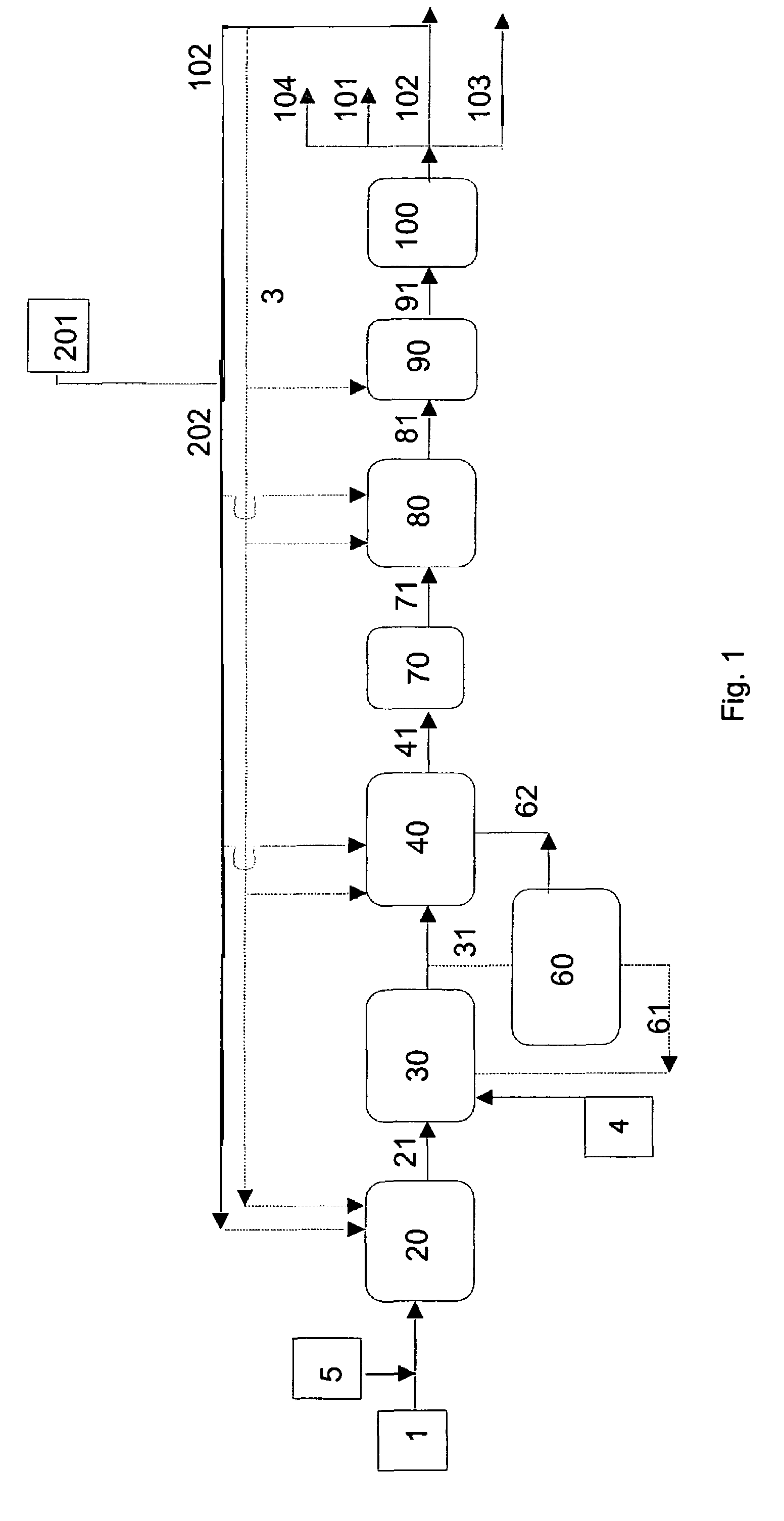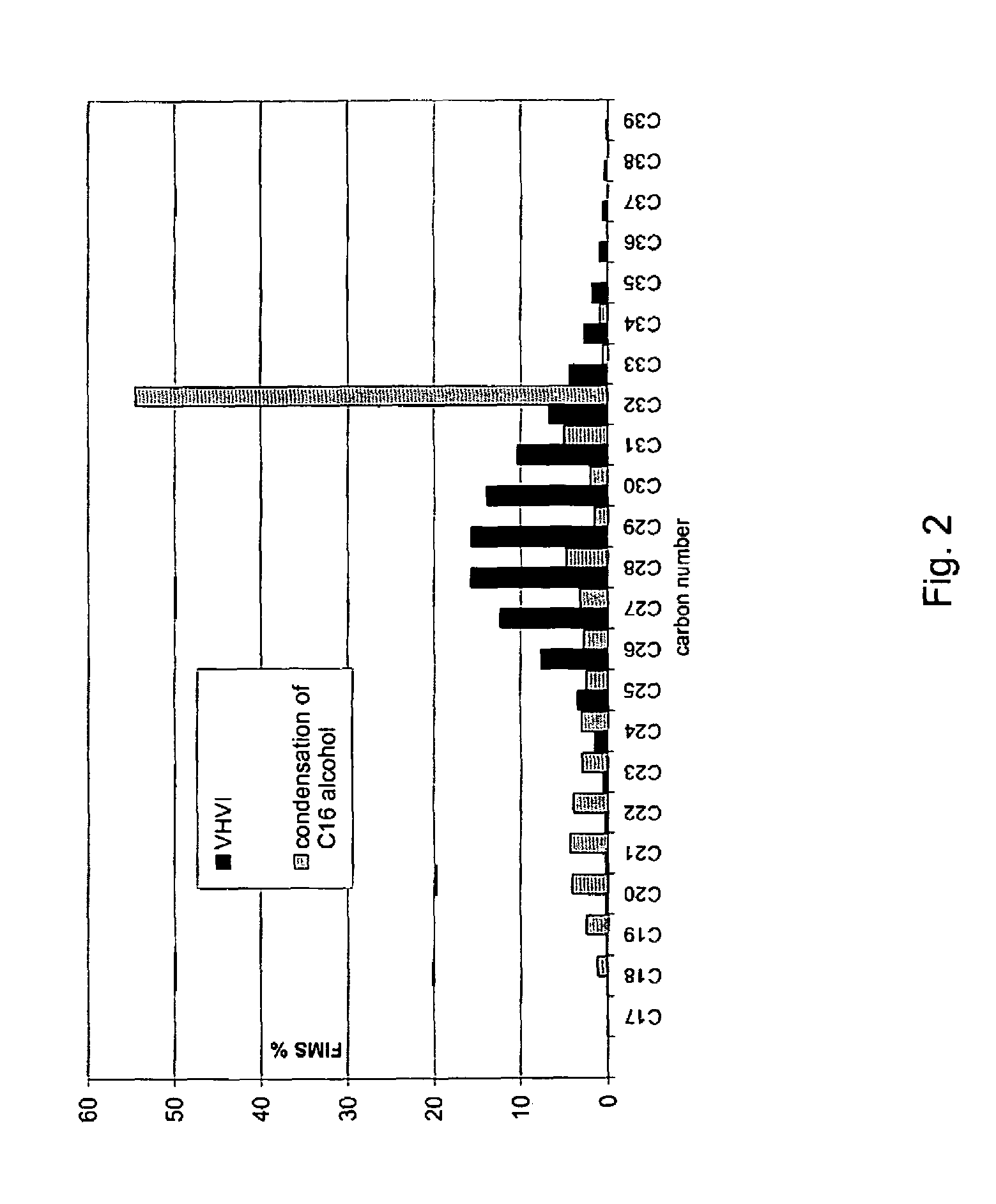Process for producing a branched hydrocarbon component
a hydrocarbon component and hydrocarbon technology, applied in the direction of hydrocarbon oil treatment products, organic chemistry, lubricant composition, etc., can solve the problems of not being able to produce lubricants that meet these demanding specifications, the response of mineral oils to antioxidant additives is often low, and the carbon dioxide emissions contributing to the greenhouse effect can be reduced, the pour point is lowered, and the effect of improving the low temperature properties
- Summary
- Abstract
- Description
- Claims
- Application Information
AI Technical Summary
Benefits of technology
Problems solved by technology
Method used
Image
Examples
example 1
[0131]Condensation of C16 alcohol derived from palm oil, followed by hydrodeoxygenation
[0132]200 g of primary saturated C16 fatty alcohol (hexadecanol), palladium chloride (5 ppm palladium) and 12 g of sodium methoxylate were put in a Parr reactor. Mixing was adjusted to 250 rpm, temperature to 250° C. and pressure to 0.5 MPa. Slight nitrogen purge was maintained to sweep out water liberated in reaction. The condensation reaction was carried out until the amount of condensed alcohol was stabilised in GC analysis. After reaction the product was neutralized with hydrochloric acid, washed with water and dried with calcium chloride.
[0133]In the next HDO step, the condensed alcohol obtained above was hydrodeoxygenated in a high pressure Parr reactor using a dried and activated NiMo / Al2O3 catalyst, to give a methyl branched paraffin. The alcohol was hydrogenated at 340° C., under a pressure of 5 MPa, mixing at 300 rpm until no alcohol peak was detected in the FTIR (infrared) spectrum. The...
example 2
[0134]Condensation of fatty alcohol derived from palm kernel oil and diol
[0135]C10 diol (1,10-decandiol, 60 g) and C12 primary alcohol (140 g), in molar ratio 1:3 were weighed in a Parr reactor. After that palladium chloride (5 ppm palladium) and 12 g of sodium methoxylate were put in the reactor. Mixing was adjusted to 250 rpm, temperature to 250° C. and pressure to 0.5 MPa. Slight nitrogen purge was maintained to sweep out water liberated in reaction. Condensation reaction was carried out until the amount of condensed alcohol was stabilised in GC analysis. After reaction the product was neutralized with hydrochloric acid, washed with water and dried with calcium chloride.
[0136]In the next HDO step, the condensed alcohol mixture obtained above was hydrogenated in a high pressure Parr reactor using a dried and activated NiMo / Al2O3 catalyst, to give a methyl branched paraffin. The alcohol was hydrogenated at 340° C., under a pressure of 5 MPa, mixing at 300 rpm until no alcohol peak ...
example 3
[0137]Hydroisomerization
[0138]The C32 paraffin wax obtained in Example 1 was isomerized in a Parr reactor to give a branched paraffin of the base oil class using a reduced Pt molecular sieve / Al2O3 catalyst. Preheated paraffin was isomerized under a hydrogen pressure of 3 MPa and at 340° C. until a pour point under −15° C. was obtained. Finally, light fractions were distilled from the product at reduced pressure. The properties of the condensed, hydrodeoxygenated and hydroisomerized baseoil are given in table 3.
[0139]It is essential to isomerize the hydrocarbon compounds produced by alcohol condensation reaction followed by hydrodeoxygenation to improve their cold properties. Due to high proportion of higher boiling compounds, the VI of the product of invention is high even though pour point is under −20° C.
[0140]
TABLE 3Carbon numbers and properties of compounds in examplesEx 1Ex 2Ex 3FIMSAverage MW451478451PARAFFINS10010090.4MONONAPHTHENES09.2DINAPHTHENES00.4TRINAPHTHENES00TETRANAPH...
PUM
| Property | Measurement | Unit |
|---|---|---|
| temperature | aaaaa | aaaaa |
| temperature | aaaaa | aaaaa |
| pressure | aaaaa | aaaaa |
Abstract
Description
Claims
Application Information
 Login to View More
Login to View More - R&D
- Intellectual Property
- Life Sciences
- Materials
- Tech Scout
- Unparalleled Data Quality
- Higher Quality Content
- 60% Fewer Hallucinations
Browse by: Latest US Patents, China's latest patents, Technical Efficacy Thesaurus, Application Domain, Technology Topic, Popular Technical Reports.
© 2025 PatSnap. All rights reserved.Legal|Privacy policy|Modern Slavery Act Transparency Statement|Sitemap|About US| Contact US: help@patsnap.com



